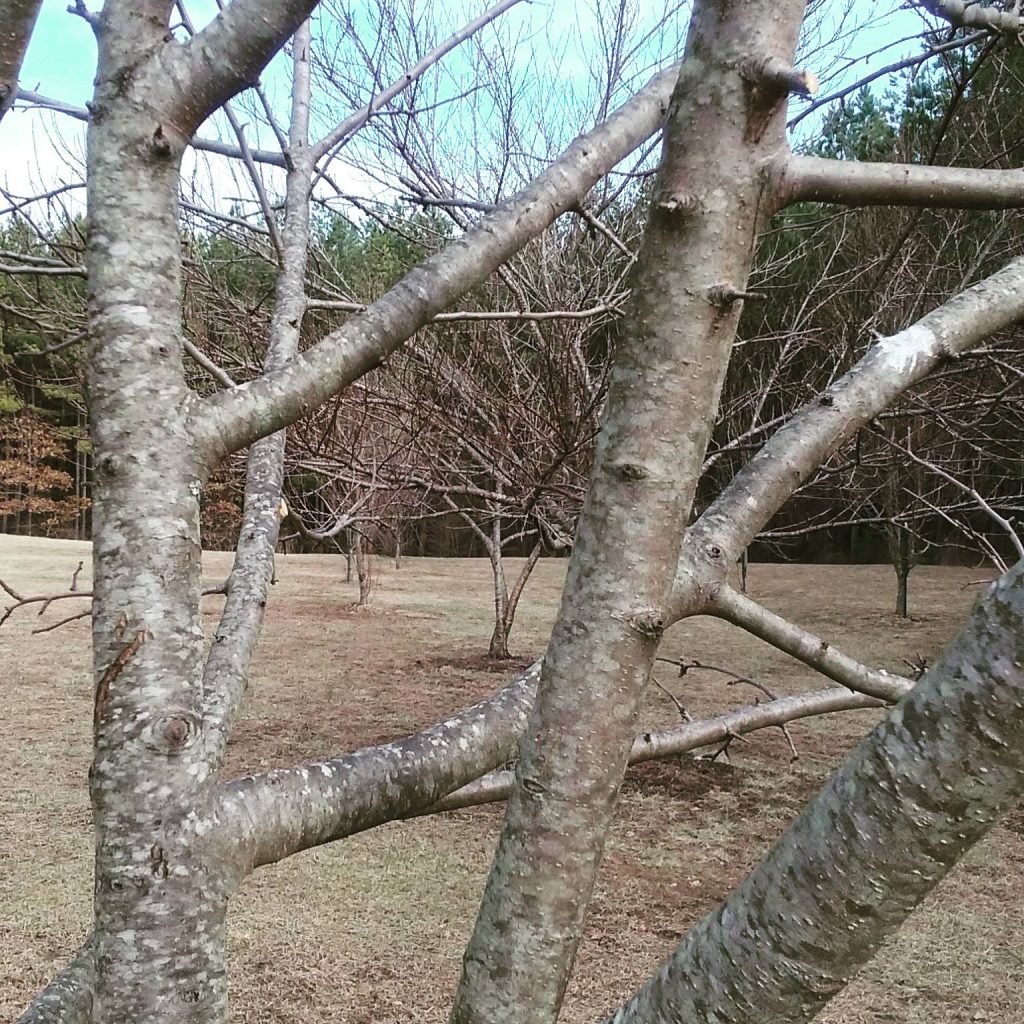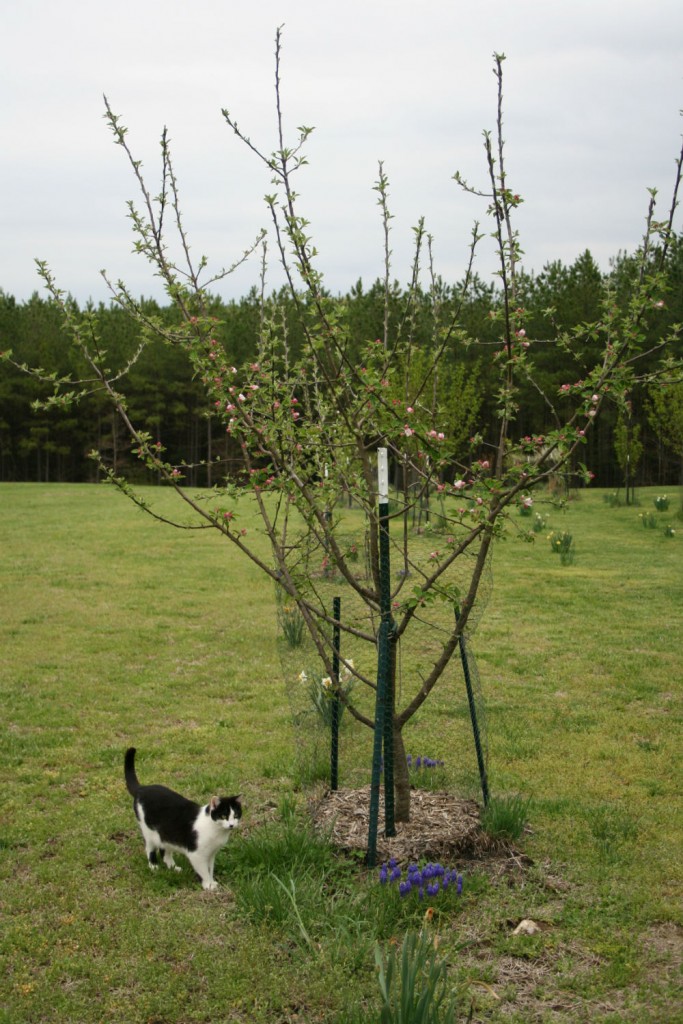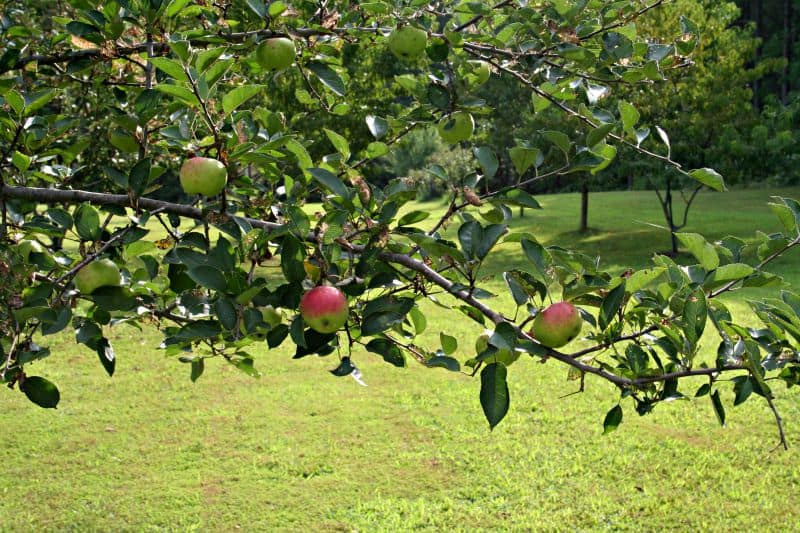Trimming apple trees, otherwise called pruning, means shaping trees by cutting off twigs, stems and branches. It’s important to prune apple trees to ensure good fruit production and healthy trees. Although it’s true that in the wild apple trees are “pruned” only by the wind and weather, in the backyard garden, pruning helps shape apple trees to prevent wind damage and to encourage abundant fruit.

Here’s when – and how – to prune apple trees.
Trimming Apple Trees
Apple trees should be pruned in late winter. This is the ideal time for trimming apple trees for several reasons:
- The tree is bare of leaves, so you can see its shape. I’ll get into why this is important later.
- Cuts made while the tree is dormant are less likely to become infected.
- Pruning stimulates new growth. The tree senses that branches have been cut off and puts energy into growth. This encourages growth in the spring, an optimal time for plant development.
Find a Day When You Can Be Outside for Trimming Apple Trees
We like to pick a day and time when we have plenty of time and aren’t rushed. Rushing through trimming apple trees leads to mistakes like taking off too many branches or shaping trees the wrong way. We currently have 9 apple trees plus about 20 other fruit trees throughout the orchard and our little hobby farm and we tackle pruning in two or three sessions in February each year.
I also like to pick a day when it’s fairly warm so that I’m not freezing while we prune. It’s hard to handle the pruning shears, loppers, and saw when you’re all bundled up with gloves and scarves and things. Depending on your climate, you may have to dress for the weather, but I much prefer a day when the temperatures are around 40 or 50 F and it’s sunny out. There’s a hint of spring in the air and it’s just nice to be outside again after the winter.
Pruning Tools: What You Need
You don’t need fancy, expensive tools for pruning, but you do need your tools to be clean and sharp.
To prune apple trees and other fruit trees, you will need:
- Hand pruners: Buy the best hand pruners you can afford because you’ll use them a lot in the garden. I like Felco pruners because you can remove the blades and replace or sharpen them, but we also have Fiskars pruners which are a good option. I like nice thick grips on the handles and brightly colored handles so I can find them if I put them down in the garden.
- Loppers: Loppers have a long handle and a blade that opens wider so you have both more leverage and a wider area to cut the branches. Loppers are used on small branches.
- Pruning saw: Pruning saws are used on larger branches. Ours has a folding blade that tucks inside the handle with a safety latch.
Rubbing Alcohol, the Forgotten Tool for Trimming Apple Trees
I rarely see this listed among pruning tools but it’s the one tool I can’t live without, and here’s why. Rubbing alcohol kills bacteria and microorganisms that can cause diseases. When you cut into a tree branch, you introduce an open wound on the tree and microorganisms can be transmitted from one tree to another through these cuts.
Think about a surgeon. Would you want a surgeon operating on you with a knife he used on the last patient and didn’t sterilize it between operations? If you just shuddered and went “ick!” then you get it. Trees, like people, can contract diseases through cuts introduced by pruning tools. Clean your tools between trees. Take the rag, pour alcohol on it, and swipe the wet rag over the cutting surface (taking care not to cut yourself in the process).
I wipe down my pruning tools between trees, not between cuts. A clean, empty coffee can filled with the bottle of rubbing alcohol and your rags is a good way to carry it around the yard. Rubbing alcohol is available in the first aid aisle of any drug store.
How to Prune Apple Trees
I only prune apple trees after they’ve been established for at least 3 years. This gives the tree plenty of time to put down roots. By waiting to prune your tree, you’ll give it plenty of time to use those leaves and branches for photosynthesis to make food for growth and development.
After three years, it may be time to start pruning. Use your judgment – if the tree looks scrawny, leave it alone. We have one tree that’s almost 10 years old and we rarely prune it and we’ve had some that needed a bit of shaping after the first year or so.
- Start by pruning any dead, broken, or damaged limbs.
- Next, stand back and look at the tree. Apple trees are pruned into ladder shapes. Imagine a child climbing the branches of the tree using the branches as ladders. That’s the shape you want your apple tree branches pruned into – alternating “ladder” branches.


When in doubt, leave a branch alone. You can always go back and prune more later but you can’t fix a tree that’s been overly pruned.
I remove “water spouts” or small twig-branches that shoot straight up from the branch. I also take out smaller branches growing from main branches, like the one in the picture above, to encourage energy to go into fruit production on the main branches.
All of the twigs, branches and stems we cut from the trees are gathered and carted into the woods where I drop them off to let them decompose naturally. We have 17 acres of woods so that gives us plenty of room. Diseased branches are bagged for the trash or burned.
The first time I trimmed apple trees, I thought I’d ruin them. The books all made it sound like rocket science. As the years go by, I feel more confident in my ability to prune fruit trees including our apple trees. It’s all part of learning homesteading skills.




